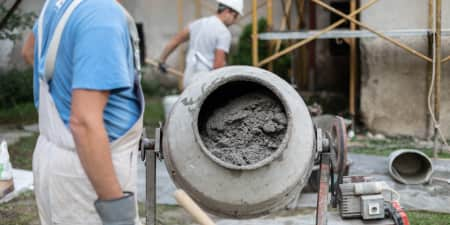How is Cement Made? A Comprehensive Guide
Cement plays a pivotal role in the development of infrastructure, standing as a cornerstone in the world of construction. From towering skyscrapers to bridges, cement is the binding force that transforms raw materials into sturdy, reliable structures.
In this comprehensive guide, we will explore the intricate process of how this essential building material gets made.
The Fundamental Ingredients of Cement
Cement's strength is created through the combination of its raw ingredients: limestone and clay. Limestone is a sedimentary rock and interacts with the clay creating a product called raw meal.
Beyond these base materials, it also includes additives like silica and alumina. These are added to the cement to give it enhanced durability, workability, and resistance to environmental elements. This process of creating cement unfolds throughout the stages of blending, grinding, and refinement, producing the high-quality material that we know today.
Step-by-Step Breakdown of the Cement Manufacturing Process
The journey of cement manufacturing unfolds in a series of systematic processes. Each step contributes significantly to the creation of one of the most used construction materials.
Step One: Extraction and Preparation of Raw Materials
The first stage is the extraction and preparation of raw materials. Quarries will mine limestone and clay, which are then put through a series of processes to refine them for manufacturing. From blasting and crushing to blending, this initial step lays the groundwork for subsequent phases, emphasizing the importance of starting with raw materials of the highest quality.
Step Two: Blending and Grinding
The second phase is the blending and grinding process, where raw materials are transformed into a mixture known as 'raw meal.' This operation demands precision to achieve the desired consistency, ensuring uniformity in the composition. The significance of this step lies in its role as the intermediary stage, setting the stage for the transformative processes that follow.
Step Three: The Kiln Phase: Clinker Production
Here, the raw meal, now a uniform blend, undergoes intense heat in the kiln. This raw meal is then heated in a kiln upwards of 1450 °C. This critical stage initiates chemical reactions, resulting in the formation of clinker, the material that exists right before cement. This process is very important for the next and final stage of cement production.
Step Four: Grinding and Addition of Gypsum
As we approach the final step, the focus shifts to the grinding of clinker and the introduction of gypsum. Gypsum is a sulfate mineral composed of calcium sulfate dihydrate. Grinding ensures the refinement of clinker into the powder form that exists right before being turned into cement.
The addition of gypsum becomes pivotal, regulating the setting time of the cement and influencing its usability. Understanding these processes offers insights into the fine-tuning that occurs, contributing significantly to the overall quality and functionality of the end product.
The Role of Technology in Modern Cement Production
Technological advancements have been instrumental in reshaping traditional cement production techniques, enhanced quality, and environmental sustainability. Automation and precision control systems optimize raw material extraction, blending, grinding, and kiln operations, accelerating production while minimizing resource waste. Real-time monitoring ensures strict quality standards, contributing to the reliability of constructed structures.
Simultaneously, sustainable practices, such as alternative fuel sources and carbon capture technologies, coupled with data analytics, are reducing the carbon footprint and optimizing supply chain logistics. This improvement in innovation, efficiency, and sustainability improves the industry's capabilities and proves its commitment to building a future where cement production is environmental responsibility.
Check out how the technology in cement trucks works.
Environmental Contemplations and Innovations
As cement continues to play an integral role in the construction industry, heightened awareness of its environmental impacts has prompted a significant shift towards innovative practices aimed at reducing its carbon footprint. The earlier methods of cement production historically contributed to environmental degradation through large carbon dioxide emissions. However, recent innovations have emerged as environmental game-changers, bringing in a new era of sustainable cement manufacturing.
One such innovation is the incorporation of alternative fuel sources in the kiln phase, replacing traditional fossil fuels. Biomass fuels and other renewable energy sources are being harnessed to not only reduce greenhouse gas emissions but also minimize reliance on limited resources.
These groundbreaking techniques showcase the industry's commitment to environmental responsibility and contribute to a more sustainable future by addressing the environmental impact associated with cement production.
Quality Control in Cement Production
The pursuit of consistent quality and strength in cement is the ultimate goal for many cement manufacturers. Making cement is a task that demands a constant commitment to quality control throughout the entire manufacturing process.
As one of the most important materials in construction, guaranteeing the reliability of cement involves layered strategies at every stage of production. From the initial extraction and preparation of raw materials to the final stages of grinding and blending, strict protocols are implemented to monitor and regulate key production requirements.
Advanced testing techniques, including X-ray fluorescence and computerized control systems, are used to monitor the chemical composition. There's real-time monitoring that allows for immediate corrective actions in response to any chemical changes, guaranteeing the uniformity and integrity of each batch. And, lastly, comprehensive physical tests are used to assess the cement's mechanical properties, such as compressive strength and setting time. All of these together provide a full evaluation of how cement is made.
Conclusion
The journey from raw materials to the final cement product is a complex and fascinating one. And while it sounds simple, with so many infrastructure projects relying on this material, it is anything but simple. Fortunately, the industry's commitment to innovation and environmental responsibility is proactively helping to build a safer and more sustainable future.
Have a construction project coming up? Find your next equipment rental on DOZR. With mini excavators, dozers, skid steers, aerial lifts, and more for rent, you can find the perfect rental for your job.

